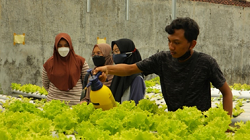Pemanfaatan Tanaman Refugia sebagai Pestisida Nabati untuk Mengurangi Serangan Hama pada Sistem Budidaya Hidroponik Utilization of Refugia Plant as a Biopesticide to Reduce Pest Attack on Hydroponic Cultivation Systems
Main Article Content
Abstract
Cultivation of plants by utilizing a small area can be developed, especially during a pandemic, among others, by using a hydroponic system. Vegetable yields (pakcoy, lettuce) do not always have good quality due to pest attacks, including in the hydroponic system, resulting in a decrease in both quantity and quality, which affects the income and turnover of this micro-enterprise (UMKM). The objectives of this service are 1) provide knowledge and skills in making biopesticides based on refugia plants or organic pesticides (“pestisida nabati”) in order to improve the quality and quantity of production, and 2) The practice of “pestisida nabati” application for hydroponic cultivation. Service activities are carried out with the following methods: providing material and discussion, making vegetable pesticides/biopesticides, and applying “pestisida nabati” in hydroponic cultivation in Micro Business Groups (UMKM "Ini Hydroponics." Accordingly, 12 participants in the training for making biopesticides and their application were practitioners, partners, and students interested in developing hydroponics. The training on making biopesticides with the essential ingredients of mischievous (Cosmos caudatus) and neem leaves (Azadirachta indica) has resulted in a solution of vegetable pesticides ready to be applied in hydroponic cultivation. The spraying application is carried out on the first day after the biopesticide is made and a week later. Based on observations of the quality of lettuce harvested a week after spraying, the product obtained showed a lower pest attack than before.
Downloads
Article Details

This work is licensed under a Creative Commons Attribution-ShareAlike 4.0 International License.
Authors who publish with this journal agree to the following terms:
- Any article on the copyright is retained by the author(s).
- Author grant the journal, right of first publication with the work simultaneously licensed under a Creative Commons Attribution License that allows others to share work with acknowledgment of the work authors and initial publications in this journal.
- Authors are able to enter into a separate, additional contractual arrangements for non-exclusive distribution of published articles of work (eg, post-institutional repository) or publish it in a book, with acknowledgment of its initial publication in this journal.
- Authors are permitted and encouraged to post their work online (e.g., in institutional repositories or on their websites) prior to and during the submission process, as can lead to productive exchanges, as well as earlier and greater citation of published work.
- The article and any associated published material is distributed under the Creative Commons Attribution-ShareAlike 4.0 International License
References
Debashri, M., Tamal, M. 2012. A Review on efficacy of Azadirachta indica Ajuss based biopestisides: An indian perspective. Research Journal of Recent Sciences. 1:94-99.
Fitmawati, Juliantari, E. 2017. Tanaman Obat dari Semak Menjadi Obat. Riau: UR-Press.
Hardiani, F., Dono, D., Nasahi, C. 2019. Effect of the Initial Temperature of Extraction of Neem Cake (Azadirachta indica A. JUSS) on its Toxicity on Crocidolomia pavonana (F.) Larvae. Cropsaver : Journal of Plant Protection. 2(1):22-29. https://doi.org/10.24198/cropsaver.v2i1.22704
Idrus, M.I., Haerul, Nassa, E. 2018. Pengendalian Hama Thrips (Thysanoptera : Thripidae) Dengan Menggunakan Ekstrak daun Kenikir (Cosmos Caudatus) Pada Tanaman Cabai Merah. Jurnal Agrotan. 4(1):46–56.
Karamaouna, F., Kimbaris, A., Michaelakis, A., Papachristos, D., Poissiou, M., Papatsakona, P., et al. 2013, Insecticidal activity of plant essential oils against the vine mealybug, Planococcus ficus. Journal of Insect Science. 13:142. https://doi.org/10.1673/031.013.14201
Kardinan, A. 2014. Insektisida nabati mimba (Azadirachtaindica: Meliaceae). Jakarta: IAARD Press.
Karta, I.W., Dewi, A.A.L.N., Wati, N.L.C., Dewi, N.M.A. 2017. uji efektivitas larvasida daun mimba (azadirachta indica) terhadap larva lalat Sarcophaga pada Daging Untuk Upakara Yadnya di Bali. (JST) Jurnal Sains dan Teknologi. 6(1):126-135. https://doi.org/10.23887/jstundiksha.v6i1.9233
Martosupono, Abas, F., Fuzzati, N., Pathak, V.N., Ren, W., Taraphdar. 2009. Ekstrak Tumbuhan Asteraceae. Jakarta: Pusat Penelitian Kimia LIPI.
Rahayu M., Pakki, T., Saputri, R. 2012. Uji Konsentrasi Cairan Perasan Daun Kenikir (Tagetes Patula Juss) Terhadap Mortalitas Ulat Penggulung Daun (Lamprosema Indica) Pada Tanaman Ubi Jalar. Jurnal Agroteknos. 2(1):36-40.
Romadania, Ardiansyah, S. 2020. Effectiveness Test of Kenikir Leaf Extract (Cosmos Caudatus) Against Death of House Flies (Musca Domestica). Indonesian Journal of Innovation Studies. 12:1-15. https://doi.org/10.21070/ijins.v12i.521
Septariani D.N, Herawati, A., Mujiyo. 2019. Pemanfaatan Berbagai Tanaman Refugia Sebagai pengendali Hama Alami Pada Tanaman Cabai (Capsicum annum L.). PRIMA: Journal of Community Empowering and Services. 3(1):1-9. https://doi.org/10.20961/prima.v3i1.36106
Subiyakto. 2009. Ekstrak Biji Mimba Sebagai Pestisida Nabati: Potensi, Kendala, dan Strategi Pengembangannya. Perspektif. 8(2):108-116. http://dx.doi.org/10.21082/p.v8n2.2009.%25p
Tuetun, B., Choochote, W., Pongpaibul, Y., Junkum, A., Kanjanapothi, D., Chaitong, U., et al. 2008. Celery-based topical repellents as a potential natural alternative for personal protection against mosquitoes. Parasitology Research. 104(1):107-115. https://doi.org/10.1007/s00436-008-1167-1
Wibawa, I.P.A.H. 2019. Uji Efektivitas Ekstrak Mimba (Azadirachta indica A. Juss.) untuk Mengendalikan Hama Penggerek Daun pada Tanaman Podocarpus neriifolius. Jurnal Agroekoteknologi Tropika (Journal of Tropical Agroecotechnology). 8(1):20 – 31.
